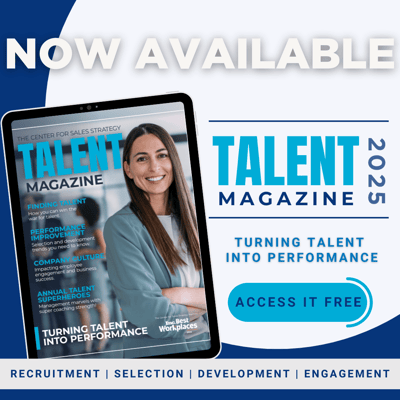
“More than ever, future hires will come from within the company. In an increasingly tight talent market, organizations will rediscover the benefits of internal hiring and work to better understand how their employees want to learn and grow.” — 2020 Talent Magazine
Recruitment is all about finding and attracting the right employee to your company. But sometimes, the individual you need to fill a vacant position already works within your existing business structure.
At The Center for Sales Strategy, we’re firm believers in always searching for talent. However, we’re also advocates for using empathy to better understand how people want to learn and grow. This is why one of the top recruitment trends in the 2020 Talent Magazine is internal recruitment.
Do Internal Candidates Usually Get the Job?
 No, internal candidates are not guaranteed to get the job. If not handled appropriately, internal recruitment can easily start contributing to an attrition problem rather than help solve it.
No, internal candidates are not guaranteed to get the job. If not handled appropriately, internal recruitment can easily start contributing to an attrition problem rather than help solve it.
In order to recruit internally, you must have an established process for internal candidates. A transparent hiring process with clear policies, assessments, and feedback is a must!
Whether through promotions, employee referrals, or transfers, internal recruitment is a way to save time, money, and resources during the hiring process.
Is the Perfect Candidate Right in Front of You?
The perfect candidate for your vacant position is often within the same organization. Taking time to evaluate the talent that already works within the company is one of the best places to begin when searching for the perfect person for an open position.
According to LinkedIn's 2020 Global Talent Trends Report, hiring managers are passive in the internal hiring process and not looking within their own companies. 72% of employees are seeking positions on their own by finding jobs on internal job boards.
Why is this happening?
- There may be a superstar on a team and their manager would hate to lose them, so they hold on tight, even if it means stunted growth opportunities for that employee. In fact, LinkedIn’s Talent Trend report indicates that 70% believe the biggest barrier to their internal movement is their manager’s attachment to talent.
- You may be pigeonholing (or labeling people) in their current position. This leads you to believe they may not have the right talents, when indeed they just may!
Many employees long for upward movement and future growth opportunities. The problem is their managers aren’t aware of these goals. Talented professionals want to work for an organization that will help them build skills and knowledge to further their careers.
Even in uncertain times, management shouldn’t minimize the importance of supporting their people’s career advancement.
5 Benefits of Internal Recruiting
Did you know in some of the world's top organizations, it's nearly impossible to land a job interview unless you're already working for the company?
When an established process is in place, internal recruiting has many benefits that can’t be overlooked.
1. Cost Less Money
You have an immediate talent pool, with no need to spend money to recruit, cutting down your expenses.
2. Transition Talents
Employees already working within an organization have demonstrated abilities in their area of expertise, and those talents may transition well to your department.
3. Save Time
They have knowledge of your industry and company. This cuts onboarding time down and makes it easier for them to hit the ground running, even in a new position. According to the LinkedIn study, 69% of managers that hire within mention productivity is accelerated as the employee is already familiar with the internal systems and culture.
4. Increase Coaching Opportunities
They are a known. You already know the good, the bad, and the ugly. This is a huge advantage for you, providing few surprises and great coaching opportunities right off the bat.
5. Improve Culture
Internal candidates are loyal and will continue to be. If you continue to hire from within, others will see there’s hope for upward movement. This increases engagement and reduces turnover.
What Are Your Next Steps to Make the Right Hire?
- Take time to define the role you are trying to fill, jotting down the talents you feel will help with success.
- Develop a list of all those in your building that have impressed you, making note of why. You may even list what you believe their strengths that would work for the role.
- Reach out to those who have impressed you and ask if they would like to discuss an opportunity to work with you.
- Make sure to send them through a validated assessment to ensure your must-have talents shine through.
- Ask other leaders in your company to recommend one of their team members — internal recommendations are great!
- Offer training courses that may be open to the entire company. This would allow you to notice interest levels.
Is the next superstar for your vacant position already in the building? Or in today’s business environment, on the other end of the Zoom call?


